5 - Successive Failure
1.0 Introduction
Successive failure of a rock slope refers to a phenomenon where multiple failures occur in a rock slope in quick succession, leading to a large-scale slope failure. This type of failure can occur when initial failures trigger additional failures as blocks are further destabilized. This analysis is important for many reasons including:
- Identifying key blocks. A key block is a block whose removal is required for the subsequent destabilization of larger masses of blocks. If key blocks are stabilized, then the slope is stabilized.
- Identifying the total failure depth behind key blocks. Bolt supports must have adequate length to anchor blocks into competent rock mass.
- Identifying extent of failure volumes due to successive failure of the slope.
This tutorial covers how to utilize the Successive Failure analysis options in RocSlope3, and view the failure iteration and failure depth of blocks.
Finished Product
The finished product of this tutorial can be found in the Tutorial 05 Successive Failure folder. All tutorial files installed with RocSlope3 can be accessed by selecting File > Recent Folders > Tutorials Folder from the RocSlope3 main menu.
2.0 Opening the Starting File
- Select File > Recent > Tutorials Folder.
- Go to the Tutorial 05 Successive Failure folder and open
the file Tutorial 05 Successive Failure.rocslope_model.
This model already has the following defined and provides a good starting point to start computing blocks:
- Project Settings
- Material Properties
- External Geometry
- Joint Properties
- Measured Joints
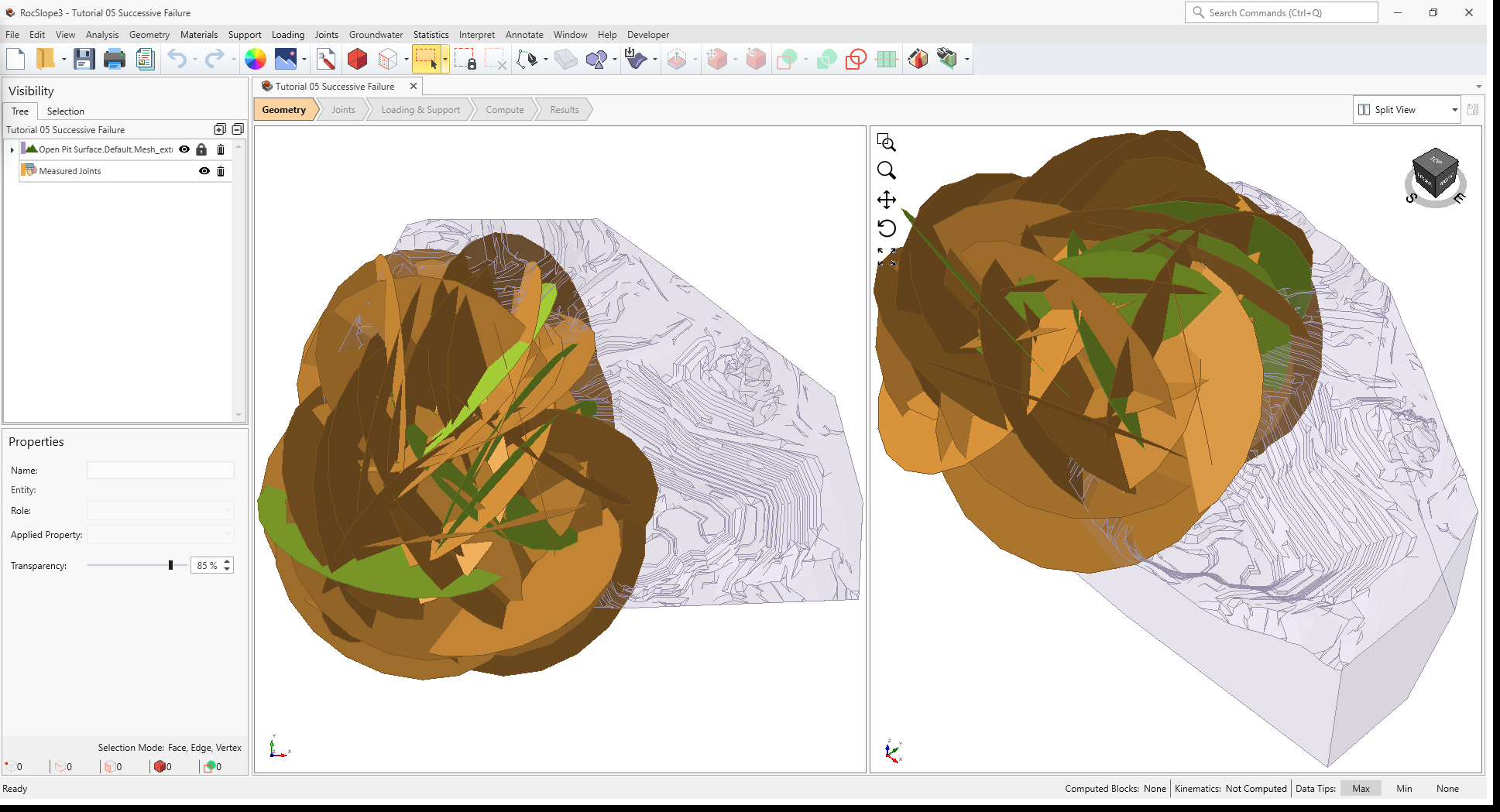
In the starting model, Measured Joints are defined over the west extents of open pit. The size of
the joints are relatively large (Radius = 500 m) so blocks have the potential of forming deep behind the free
surface of the slope, some completely behind daylighting blocks.
2.1 Project Settings
Review the Project Settings.
- Select Analysis > Project Settings

- Select the Units tab. Ensure Units are Metric, stress as
MPa.
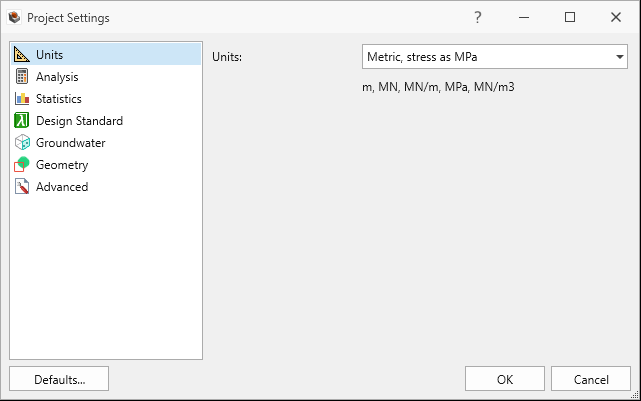
Units tab in Project Settings dialog - Select the Analysis tab.
- Ensure Design Factor of Safety = 1.5.
- Ensure Successive Failure is ON. We will be analyzing successive failures by iterating through each stage of failed blocks until no more blocks can be removed.
- Click Cancel to exit the dialog.
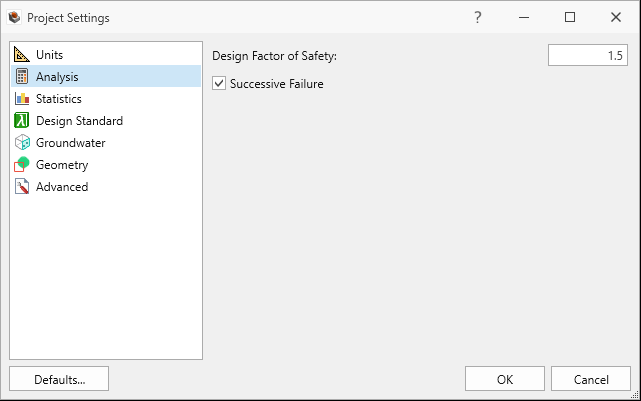
2.2 Material Properties
Review the Material Properties.
- Select Materials > Define Materials

- One (1) material property is defined in the Define Materials dialog. The Schist material property has:
- Unit Weight = 0.026 MN/m3.
- No Water Surface applied.
- Click Cancel to exit the dialog.

2.3 External Geometry
The External is of a pit shell and composed of one volume assigned with the Schist material property.
2.4 Joint Properties
Review the Joint Properties.
- Select Joints > Define Joint Properties
 . Two (2) joint properties are defined.
. Two (2) joint properties are defined. - The Smooth joint property has:
- Strength Type = Mohr-Coulomb
- Cohesion = 0 MPa
- Phi = 10 degrees
- Waviness = 0 degrees
- Water Pressure Method = Dry
- The Rough joint property has:
- Strength Type = Mohr-Coulomb
- Cohesion = 0 MPa
- Phi = 30 degrees
- Waviness = 0 degrees.
- Water Pressure Method = Dry
- Click Cancel to exit the dialog.
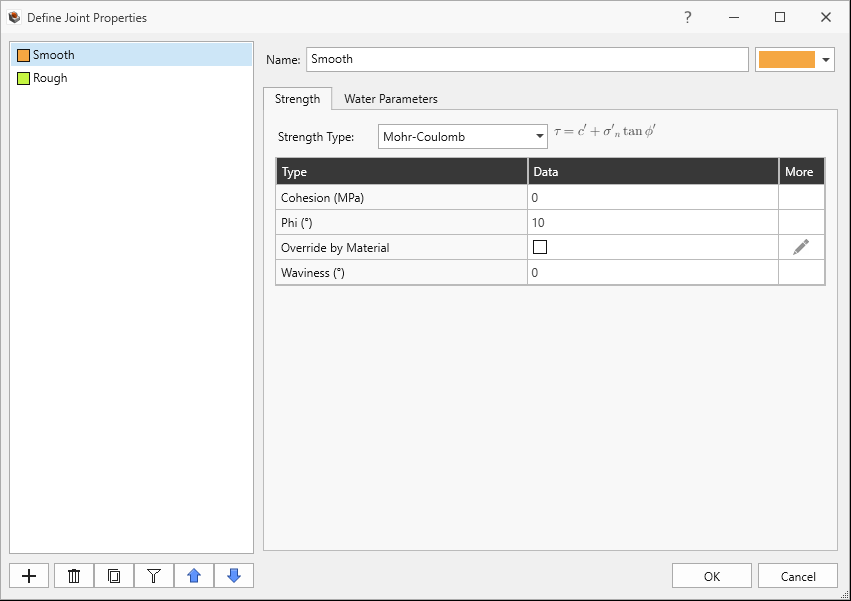
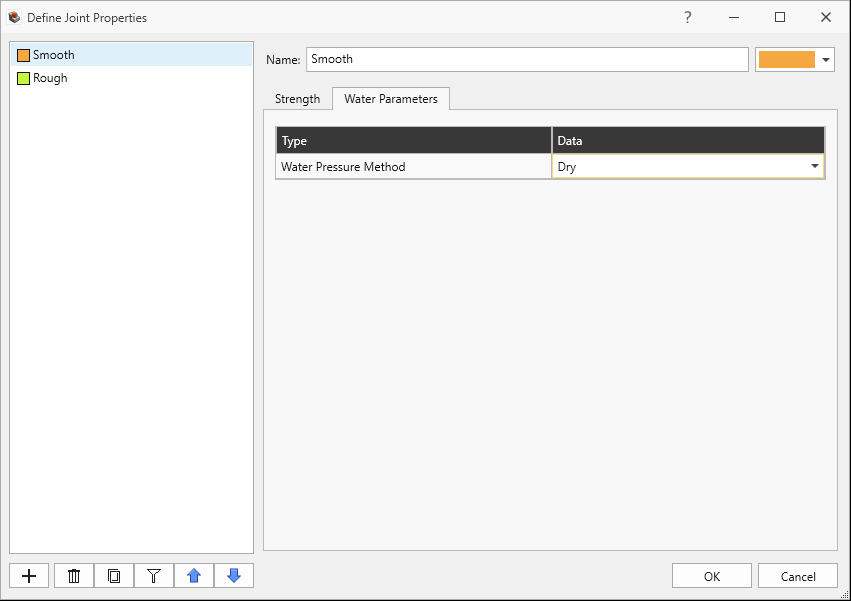
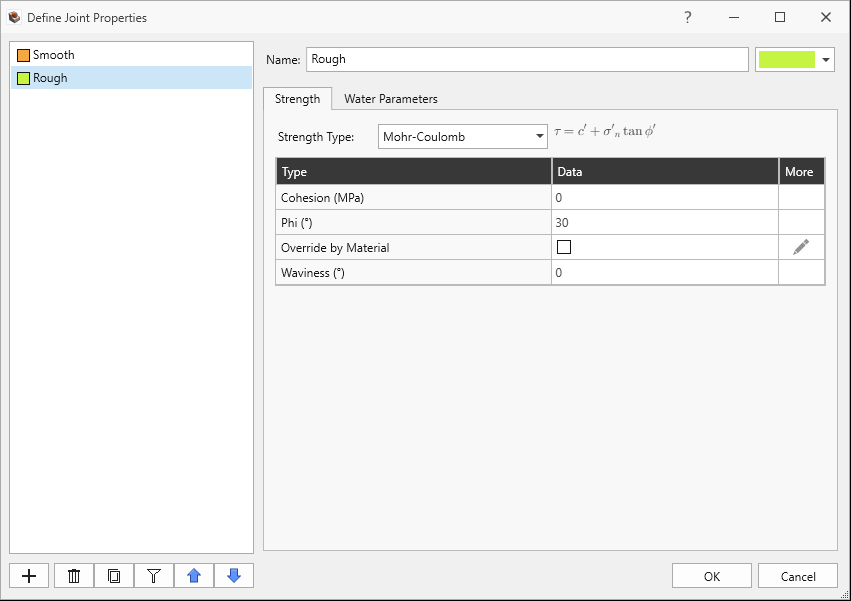
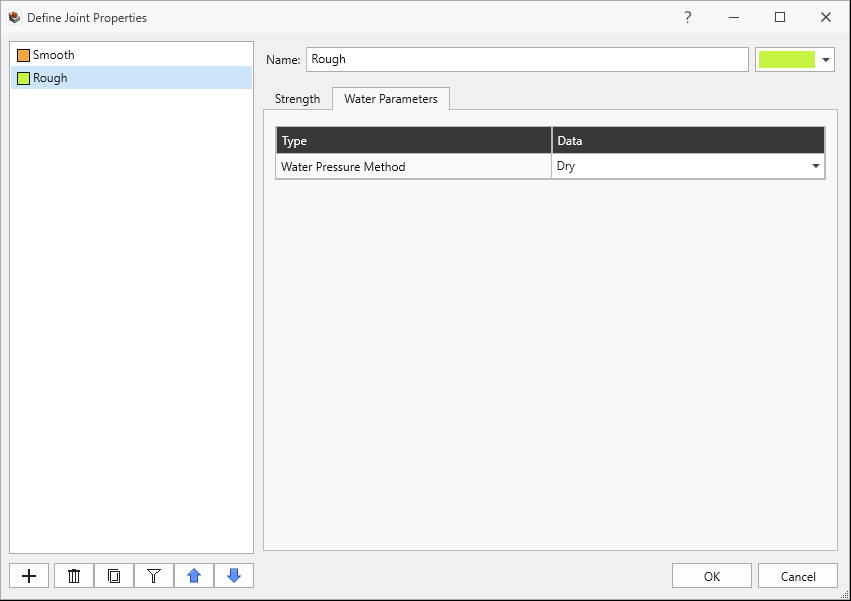
2.5 Measured Joints
Review the Measured Joints.
- Select Joints > Define Measured Joints
 . 40 Measured Joints are defined.
. 40 Measured Joints are defined. - Click Cancel to exit the dialog.
Listed in order of Dip, Dip Direction, X, Y, Z, Radius, and Joint Property:
| Dip | Dip Direction | X | Y | Z | Radius | Joint Property |
|---|---|---|---|---|---|---|
| 59 | 48 | -390 | -115 | 1018 | 500 | Rough |
| 77 | 131 | -319 | -337 | 1004 | 500 | Rough |
| 78 | 123 | -313 | -157 | 1003 | 500 | Rough |
| 78 | 313 | -486 | 128 | 1037 | 500 | Rough |
| 61 | 13 | -793 | -447 | 1099 | 500 | Rough |
| 89 | 255 | -272 | -65 | 994 | 500 | Smooth |
| 51 | 341 | -375 | -594 | 1015 | 500 | Smooth |
| 67 | 107 | -548 | 47 | 1050 | 500 | Smooth |
| 57 | 86 | -281 | 91 | 996 | 500 | Smooth |
| 82 | 105 | -758 | 33 | 1092 | 500 | Smooth |
| 53 | 62 | -546 | -100 | 1049 | 500 | Smooth |
| 46 | 84 | -665 | -224 | 1073 | 500 | Smooth |
| 55 | 79 | -772 | -386 | 1094 | 500 | Smooth |
| 29 | 223 | -798 | -400 | 1100 | 500 | Smooth |
| 50 | 82 | -305 | 193 | 1001 | 500 | Smooth |
| 34 | 33 | -699 | -504 | 1080 | 500 | Smooth |
| 39 | 57 | -348 | -272 | 1010 | 500 | Smooth |
| 81 | 36 | -258 | -51 | 992 | 500 | Smooth |
| 58 | 314 | -544 | -193 | 1049 | 500 | Smooth |
| 39 | 211 | -744 | -599 | 1089 | 500 | Smooth |
| 81 | 268 | -797 | 108 | 1099 | 500 | Smooth |
| 65 | 336 | -455 | 104 | 1031 | 500 | Smooth |
| 78 | 317 | -575 | -54 | 1055 | 500 | Smooth |
| 62 | 133 | -656 | -479 | 1071 | 500 | Smooth |
| 27 | 283 | -769 | -258 | 1094 | 500 | Smooth |
| 30 | 167 | -458 | -465 | 1032 | 500 | Smooth |
| 33 | 132 | -253 | -539 | 991 | 500 | Smooth |
| 60 | 336 | -580 | 80 | 1056 | 500 | Smooth |
| 30 | 39 | -583 | 168 | 1057 | 500 | Smooth |
| 28 | 76 | -362 | -30 | 1012 | 500 | Smooth |
| 17 | 101 | -362 | -432 | 1012 | 500 | Smooth |
| 10 | 249 | -511 | -162 | 1042 | 500 | Smooth |
| 19 | 343 | -631 | 112 | 1066 | 500 | Smooth |
| 45 | 58 | -789 | -329 | 1098 | 500 | Smooth |
| 26 | 213 | -628 | 60 | 1066 | 500 | Smooth |
| 84 | 351 | -516 | -421 | 1043 | 500 | Smooth |
| 51 | 162 | -339 | -320 | 1008 | 500 | Smooth |
| 49 | 178 | -253 | -309 | 991 | 500 | Smooth |
| 77 | 291 | -403 | 114 | 1021 | 500 | Smooth |
| 54 | 51 | -417 | -421 | 1023 | 500 | Smooth |
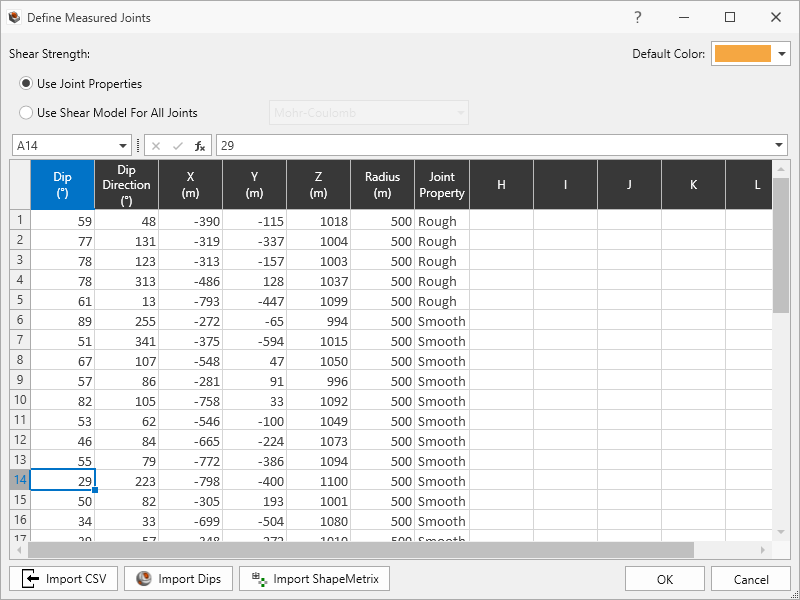
3.0 Compute
RocSlope3 has a two-part compute process.
3.1 Compute Blocks
The first step is to compute the blocks which may potentially be formed by the intersection of joints with other joints and the intersection of joints with the free surface.
To compute the blocks:
- Navigate to the Compute workflow tab

- Select Analysis > Compute Blocks

As compute is run, the progress bar reports the compute status. Once compute is finished, the Results node is added to the Visibility Tree and All Valid Blocks are blocks are shown in the viewport. The Results node consists of the collection of valid blocks and the socketed slope. The original External and Measured Joints visibility is turned off.
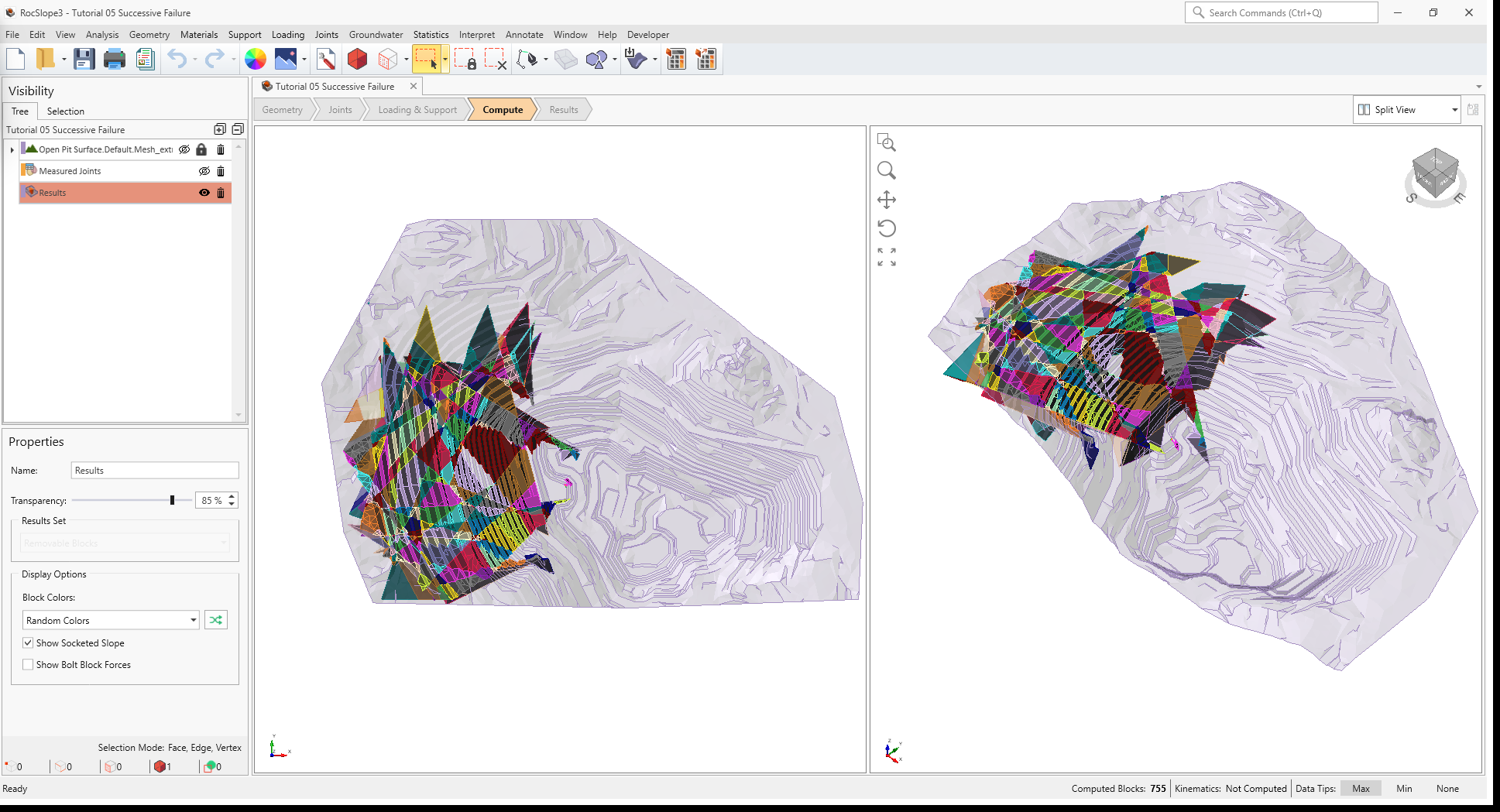
Once compute is finished, the blocks are coloured according to the Block Color option (Random
Colors) set in the Results node's Property pane.
Compute Blocks only determines the geometry of the blocks. In order to obtain other information such as the factor of safety, Compute Kinematics needs to be run.
3.2 Compute Kinematics
The second and final compute step is to compute the removability, forces, and factor of safety for each of the valid blocks.
To compute the block kinematics:
- Ensure that the Compute workflow tab
 is the active workflow.
is the active workflow. - Select Analysis > Compute Kinematics

As compute is run, the progress bar reports the compute status. By default, after Compute Kinematics
is run, only Removable Blocks are shown.

In a Successive Failure mode of analysis, several Failure Iterations may be performed. In the first Failure Iteration, only immediately removable daylighting blocks are analyzed. Any blocks which have a factor of safety less than the Design Factor of Safety (set in Project Settings) is considered "failed". These blocks are also known as "key blocks". The stability of key blocks control the global stability of the slope. As key blocks fail and are detached from the slope, potential constraints in joint faces (in regards to removability and valid sliding direction) are removed and become free faces which no longer support the block or provide shear resistance to sliding. As such, the failure proceeds in a successive manner. See the Analysis topic for more information on Successive Failure.
4.0 Interpreting Results
Once both blocks and kinematics are computed, all block results can be viewed in a table format.
4.1 Block Information
To view all block results:
- Navigate to the Results workflow tab

- Select Interpret > Block Information

Visualizing blocks can be difficult when the slope extents are large compared to the block extents.
To zoom into all blocks:
- Select Interpret > Zoom To All Blocks

The Block Information pane shows the collection of blocks according to the Results Set settings. The Results Set shown can be selected in the Results tab of the Display Options, or the Properties pane for the Results Node. By default, only Removable Blocks are coloured. In the case of Successive Failure, it may be more beneficial to only colour the failed blocks. Failed blocks are blocks which have a factor of safety less than the Design Factor of Safety.
To colour Failed Blocks Only:
- Select View > Display Options

- Navigate to the Results tab in the Display Options dialog.
- Set Results Set = Failed Blocks (FS < Design FS)
- Click OK to close the dialog.
OR
- Select the Results node from the Visibility Tree.
- In the Results node Properties pane, set Results Set = Failed Blocks (FS < Design FS).
Failed Blocks Only are now coloured according to Random Colors.
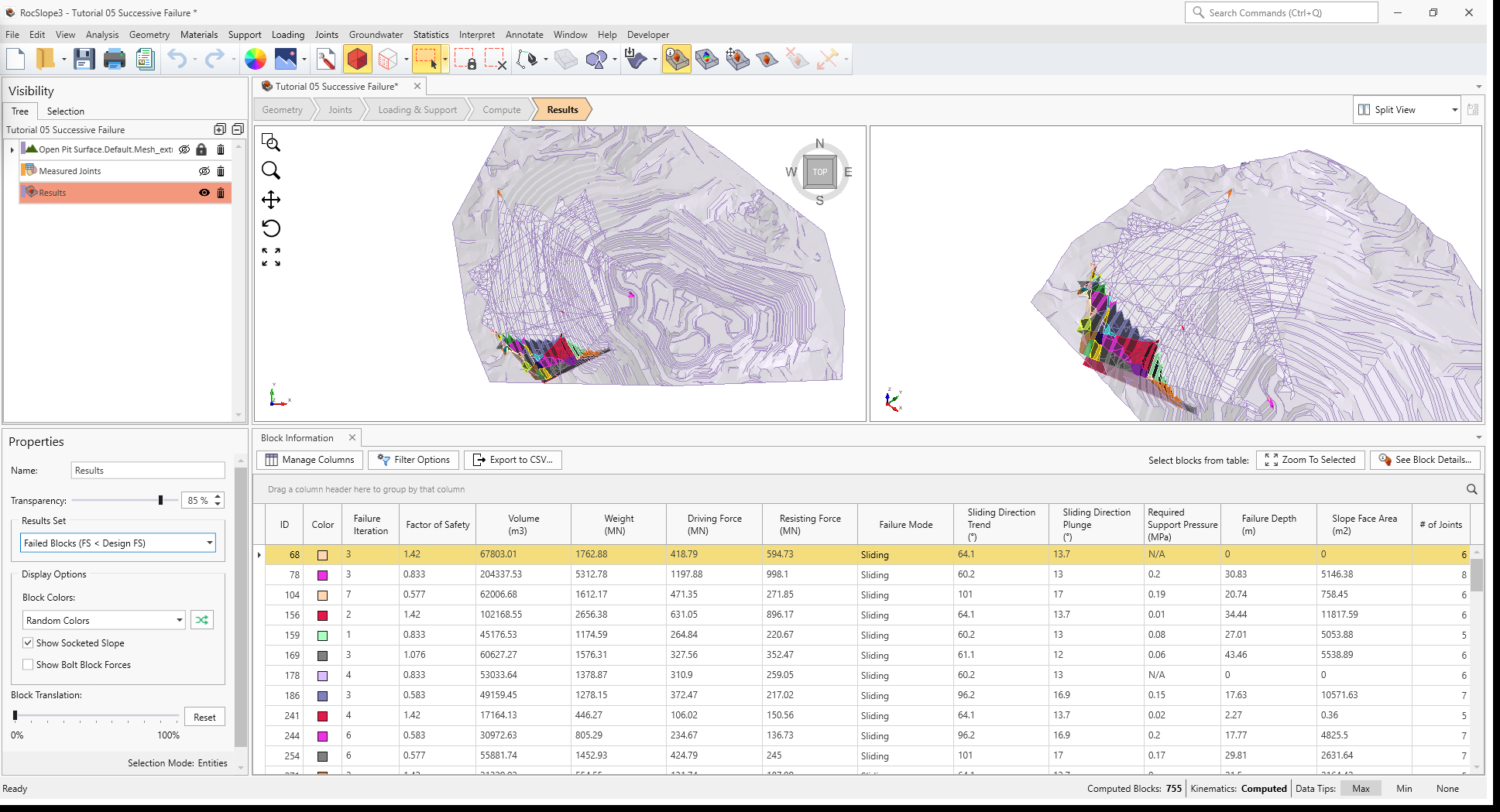
Note that the Failure Iteration column is visible for a Successive Failure analysis. The Failure Iteration indicates the the step in which the block fails. It is not a true representation of the complex unraveling mechanism, but rather for notation and filtering.
4.2 Edit Filters
To see the progressive unravelling of the slope, we can toggle the Failure Iteration quick filter under the Filter Options > Edit Filters section.
- At the top of the Block Information pane, click Filter Options

- Expand the Edit Filters section.
- For the Failure Iteration quick filter, increase the minimum value from 1 to 2 and hit ENTER. All blocks which are immediately removable and have failed (i.e., key blocks) are filtered out and hidden in the viewport.
- Step 2 can be repeated to show the successive failure of the slope.
- Select the Clear Filter button to remove the filter.
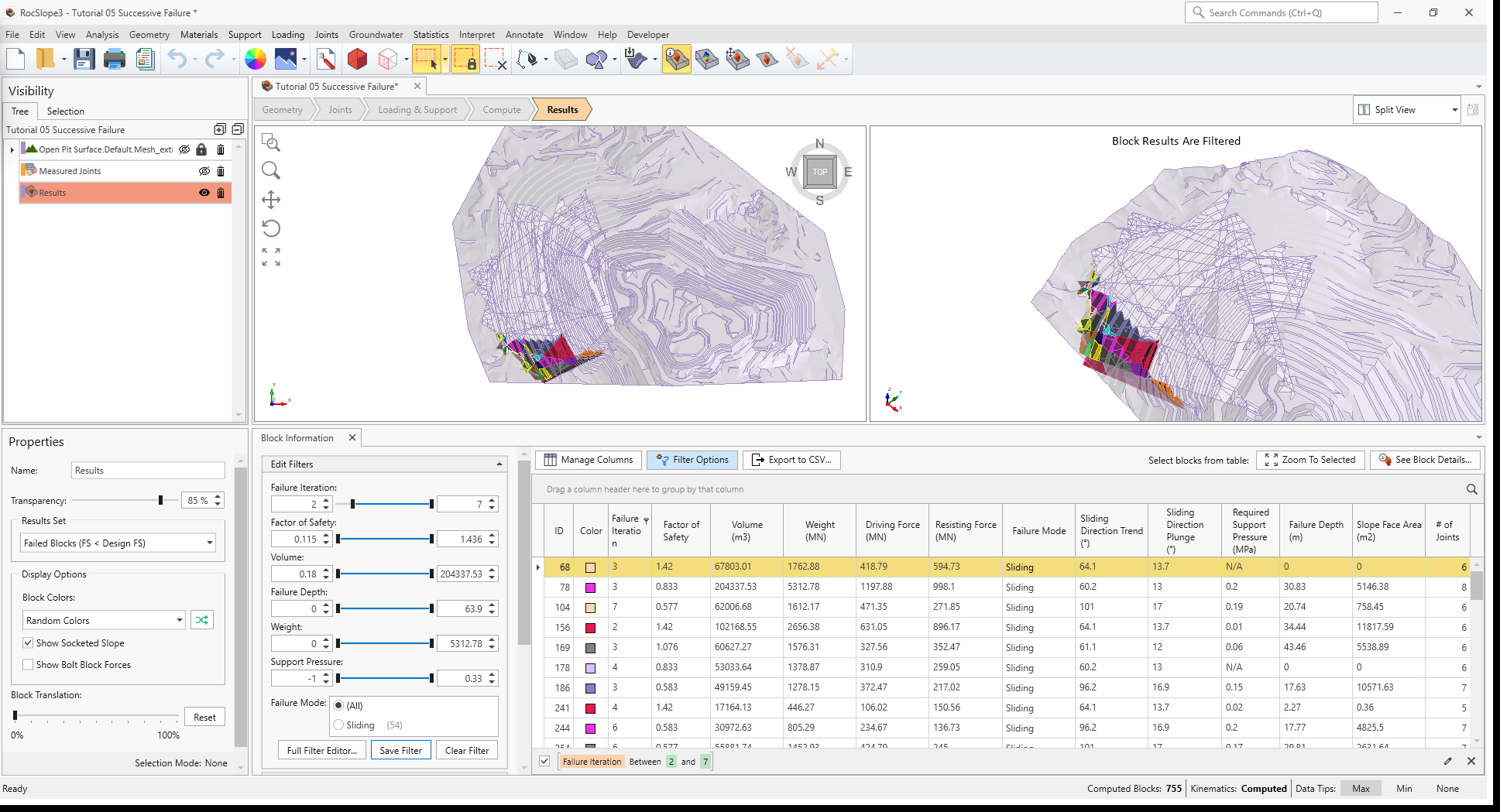
Alternatively:
- Hover the mouse over the Failure Iteration header in the Block Information listing and click the small filter
symbol
 that appears.
that appears. - In the Filter Rules tab, set the operator to Is greater than and the value to 1; OR
- In the Filter Values tab, select all checkboxes except leave 1 unchecked. The key blocks are hidden.
- Select the Clear Filter button in the pop-out dialog to remove the filter.
4.3 Contour Blocks
In RocSlope3, blocks can be contoured by several metrics. In a Successive Failure analysis, the Failure Iteration and Failure Depth are especially relevant.
To show block contours:
- Select Interpret > Contour Blocks

- From the Contour pane on the right of the screen, select Failure Iteration.
Blocks are coloured by the failure iteration that it belongs to. This is also an easy way to quickly identify
key blocks and visually see the effects of block failures on adjacent blocks.
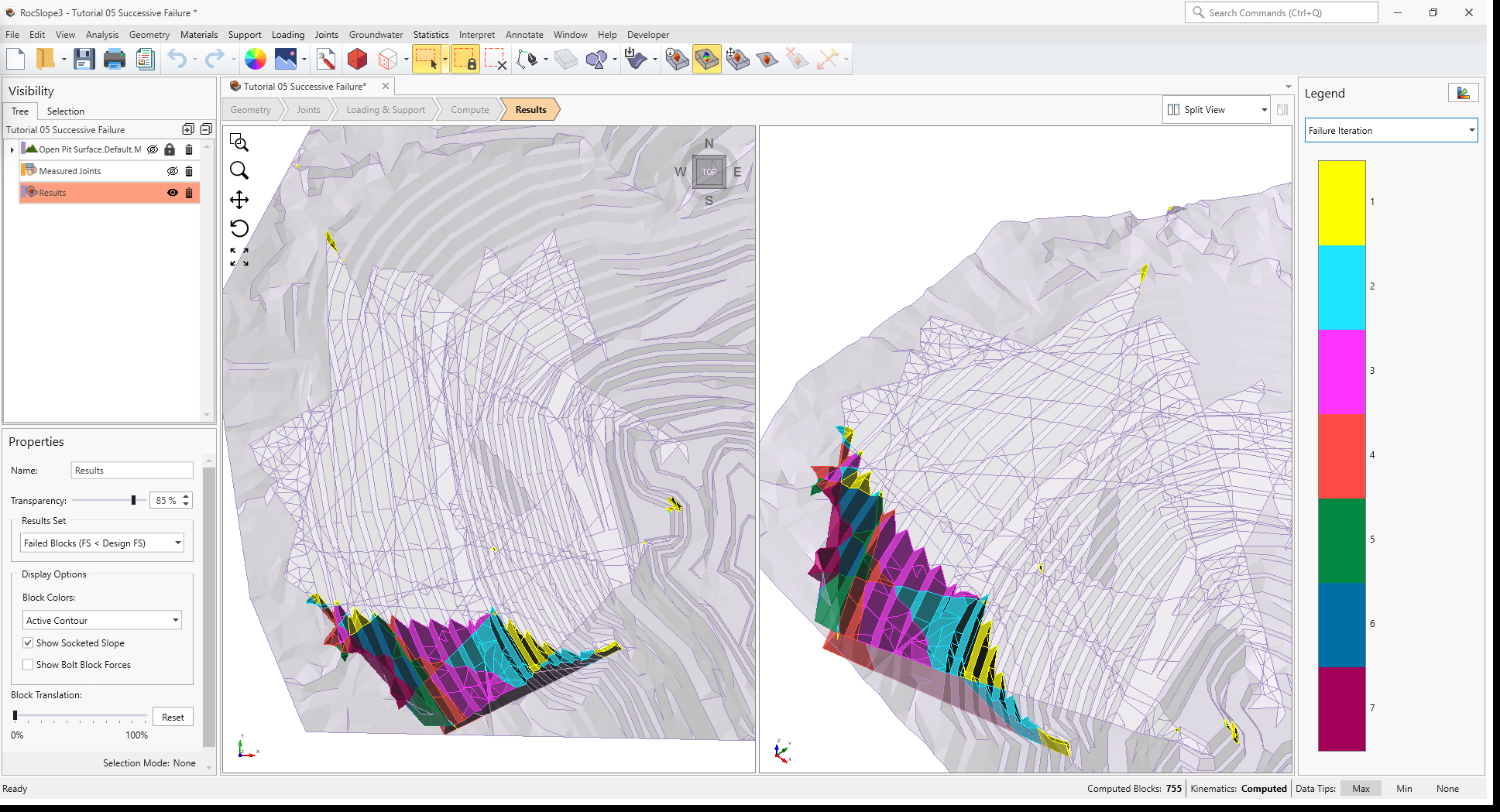
3D View of Failed Blocks contoured by Failure Iteration - From the Contour pane on the right of the screen, select Failure Depth. The
daylighting blocks are contoured by the maximum Failure Depth, measured from the free surface
to the deepest failed block, in a direction normal to the free surface. This metric is a good indicator of the
minimum bolt length required to anchor into competent rock if bolts are installed normal to the slope surface.

3D View of Failed Blocks contoured by Failure Depth
This concludes Tutorial 05.